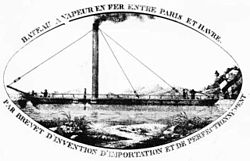Manby (ship)
|
||||||||||||||||||
|
||||||||||||||||||
|
||||||||||||||||||
The Manby was an iron river steamer . The ship is also known as Aaron Manby , but was never registered under that name. The Manby is considered to be the first sea-going steamship built entirely from iron.
prehistory
In 1819, the Vulcan was the first ship with an iron hull to be built. Charles John Napier , who dreamed of a steamship fleet on the Seine , had the idea of building an iron steamship. Aaron Manby was the owner of what was then the largest iron foundry in France in Le Creusot and also had a significant share in passenger travel on the Seine. He therefore dared the bold step of constructing a ship with a completely iron hull and using it between the trading centers of Paris , Rouen and Le Havre .
The ship
The Manby was built in 1821 by the Horseley Iron Works in Tipton , Staffordshire according to the joint plans of Charles Napier, Aaron Manby and his son Charles Manby. Then it was dismantled and transported overland to the Surrey Docks at Rotherhithe near London , where it was reassembled in 1822. This alone was already considered a pioneering act.
The Manby was a 32.56 meter long, 5.23 meter wide and 2.18 meter deep side paddle steamer of 116 tons burthen ( Builder's Old Measurement ). The hull, flattened at the bottom, consisted of 6 mm thick iron plates. The ship had a wooden deck and a bowsprit . The drive consisted of a two-cylinder oscillation steam engine with an output of around 30 hp, designed and patented by Aaron Manby (British Patent No 4558 of 1821) and built by his shipyard. It allowed a speed of around seven knots. The paddle wheels had a diameter of 3.70 m, but were only 0.76 m wide, as the total width of the ship for the journey on the Seine was not allowed to exceed 7 m. Contemporary representations show an elongated, narrow hull without any deck superstructures except for a very high, thin chimney that was stiffened with rope and had a height of about 14 m.
history
The ship was first registered on April 30, 1822 for Aaron Manby in London, a few days later, on May 3, 1822 it was registered for C. Napier and A. Manby in London. After the new building had completed its test drive between Battersea and Blackfriars on May 9, 1822 , the Manby began her maiden voyage to France in June . She crossed the English Channel in the fall of 1822 and it was falsely claimed that the Manby was the first steamship to cross the English Channel. However, this was already achieved in 1816 with the paddle steamer Margery , which was still equipped with a wooden hull. After the Manby had crossed the canal a few times, she was used as a mail ship and pleasure steamer on the Seine between Paris and Le Havre . In 1830 the ship, which had been operating under the British flag, was sold to the French Compagnie des bateaux a vapeur en fer and in 1836 it was used for a service on the Loire for an operator from Nantes . After 20 years of service, the Manby was initially launched in 1842. It was finally scrapped in France in 1855.
literature
- Duncan Haws: Ships and the Sea. Chronicle of the seafaring. Weltbild, Augsburg 1994, ISBN 3-89350-054-5 .
- B. Greenhill: The Advent of Steam . London 1993, p. 27 (English).
- NW Kennedy: Records of the Early British Steamships . Liverpool 1933, p. 19 (English).
- Alfred Dudszus, Ernest Henriot, Alfred Köpcke, Friedrich Krumrey: The great book of ship types . tape 2 . Weltbild, Augsburg 1995, ISBN 3-89350-831-7 , p. 29 .
Footnotes
- ^ Sea Breezes Vol. 15, Liverpool, 1953, p. 249.
